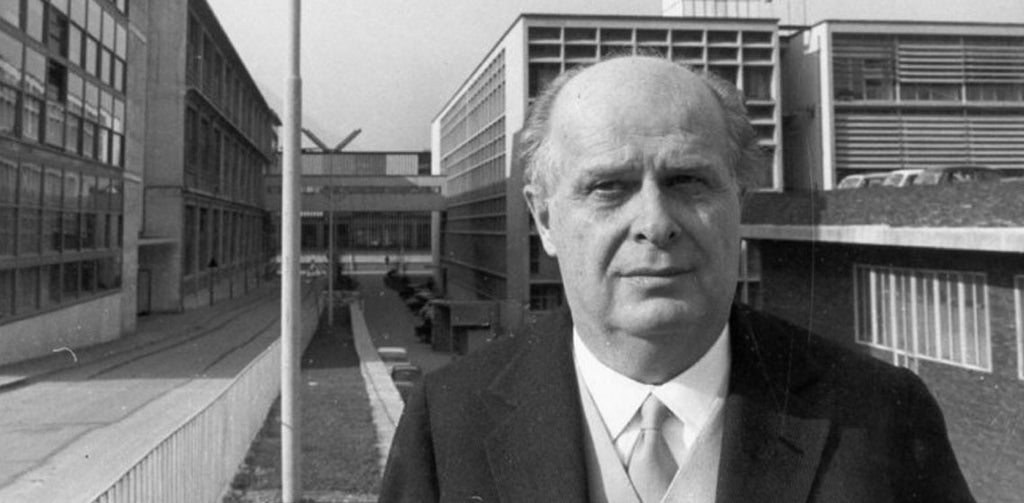Adriano Olivetti, the Engineer that made an Empire from Welfare and Research

 Adriano Olivetti standing in front the Olivetti Building designed by Luigi Figini and Gino Pollini.
Adriano Olivetti standing in front the Olivetti Building designed by Luigi Figini and Gino Pollini.
Born in the small town of Ivrea in 1901, Adriano Olivetti was one of the most farsighted entrepreneurs of the twentieth century. He joined advanced technology and design, with his new vision of welfare rights and the way work was organized. Adriano managed his father’s business, the Olivetti typewriter company, launching its establishment globally and inventing some of the most innovative products of our time.
From the beginning of the factory’s foundation in 1908, his father Camillo believed that humble people with propositive attitudes and intelligence could be taught and educated. Camillo’s vision was a modern idea at the time.
Adriano Olivetti: the early years and the first infrastructures
Adriano had a socialist and jewish education, graduated in Chemical Engineering in Turin and started working in his father’s factory with the factory workers in 1924.
In 1932, during the fascist hegemony in Italy, Adriano becomes director of Olivetti and after a few years, president. In harmony with his idea of wellness in the workplace, he called upon some of the most important architects of the time to build structures for the workers, such as The nursery school or The worker’s housing by Gino Pollini and Luigi Figini.


These structures, like the free health care system and the public library are just some of the welfare concepts and implementations that Adriano provided for his workers and their families.
Ivrea evolved from a small agricultural town to a thriving city that could meet all the needs of its inhabitants. Olivetti designed and built one of the best local welfare states of its time.
Probably the most important idea is the Consiglio di Gestione (Management Council), where employees and directors could debate and deliberate new proposals to improve the workers conditions with new welfare states. It was a sort of an internal labor union, where all the needs of the employees were evaluated and, if possible, put into action.

After Adriano Olivetti the dream continues: the Programma 101
The same ideas and principles of welfare were shared with the customers, since all the products they offered had to be easily understood and with a practical design. Even the Museum of Modern Art of New York (MOMA) made an exhibition about Olivetti's designs and architectures. Since 1954 Olivetti won six Compasso d’Oro with some of the most important designers in Italian history, such as Marcello Nizzoli (Lettera 22), Ettore Sottsass Jr. (Olivetti Elea 9003, Olivetti Summa 19), Michele De Lucchi (Stampante Artjet 10) and many others.
The most important product Olivetti invented was definitely the Programma 101 commissioned two years after the death of Adriano to engineer Giorgio Perotto, supported by technician Giovanni De Sandre and designers Gastone Garziera and Mario Bellini. With simplicity and beauty, they had to transform the computer (a monster usually thought as a military or hi-tech science issue), into a practical desk object. The task was enormous: change a colossal machine into something small and capable to do the hardest calculations of the time. Similar to kickstarter projects, brave visionary people couldn’t finance a complicated project themselves. Olivetti believed in the venture and invested in the project, with no guarantee of its success.

Since the death of Adriano in 1960, the company was in dire straits and couldn’t face the needs of the growing market of electronics. So Programma 101 got shelved and needed another year to be presented at the BEMA in New York. It was showcased in a small room just to test the reactions of some curious bystanders. The main attraction presented by Olivetti was the Logos 27, a mechanical calculator. But when people noticed that small computer in the background, no one could believe that such innovation was possible! Finally, everybody could use a computer without being a scientist, sitting comfortable at their desk and at a really low price! The success was so great, that even NASA decided to use it to calculate the landing of the Apollo 11!


Curiously, the patent was sold to Hewlett-Packard for 900.000 dollars, while Perotto had sold the project to Olivetti for only one dollar! He would later say “Never before has a dollar been spent better by a company!”.
Since then, PC started appearing in our homes, changing completely how we see communications, live our lives, and was the beginning of the Personal Computer History.
So when you think about projects, technical innovation, and a better future, think of Olivetti: if you believe in people, even the smallest and simplest things can change tomorrow.
For further information, check out the following links:
- Fondazione Adriano Olivetti
- Città dell'uomo, a book about Adriano Olivetti's ideals.
- Documentary: Programma 101, the Machine that Changed the World.
- Documentary: The Future Lies With Me....




Leave a comment